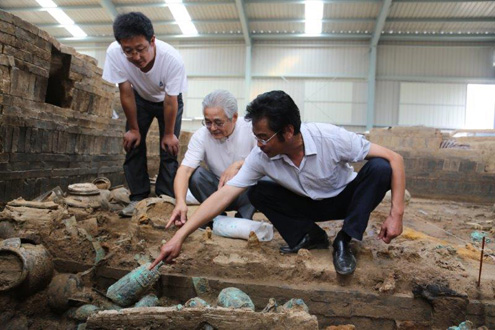InAsia
Insights and Analysis
Leading Chinese Archaeologist Offers Glimpse into Life of Han Dynasty King
January 13, 2016
In November, preeminent Chinese archaeologist, Li Zebin, gave a presentation at The Asia Foundation in San Francisco about the excavation he helped lead on what is considered one of the most important archaeological discoveries in China in recent years: A 2,100-year-old tomb of a Chinese king, discovered in Jiangsu Province eight years ago.

Preeminent Chinese archaeologist and Williams’ Fellow Li Zebin shows pieces from the excavation he helped lead on one of the most important archaeological discoveries in China in recent years.
Li, who serves as the deputy director of the Jiangsu Provincial Institute of Archaeology at the Nanjing Museum, is a 2015 Margaret Williams Fellow in Asian Art, a fellowship jointly administered by The Asia Foundation and the Asian Art Museum of San Francisco.
The Dayunshan mausoleum is the final resting place of Liu Fei (169-127 B.C.E.) of the Jiangdu kingdom. Li and his team at the Nanjing Museum conducted the excavations from 2009 to 2011. Liu Fei’s tomb and those of his many consorts reveal a powerful regent’s sumptuous lifestyle. The complex included pits containing life-sized chariots, a treasury with thousands of coins, and a kitchen filled with utensils and urns still containing food. Plans are now underway to bring a visiting exhibit of some of the artifacts to the Asian Art Museum in 2017, said Li.
China’s economic developments have created many opportunities for Chinese cultural preservation, but at the same time have brought about new challenges. There are many more museums now throughout the country, housing cultural relics that showcase China’s cultural heritage. There is also a booming market for antiques and antiquities, and private collectors can indulge their interests at auction houses international and domestic, not to mention the illegal markets.
To be sure, China has taken measures to safeguard its cultural heritage. Li explained that there are laws specifically drafted for conducting archaeological site excavations and protection of cultural relics. Stringent assessment procedures for archaeological excavations and protection of cultural monuments are in place. It is also obvious that these measures are still far from sufficient in a large and rapidly developing country.
Ye Wa, an archaeologist at UCLA’s Cotsen Institute of Archaeology, said there is often a conflict between developers and cultural preservationists when it comes to archaeological excavations. She has been working on a dig of Yanguanzhai, a Neolithic village near Xi’an, for the past few years. The laws sometimes do not go far enough to protect cultural sites, she said. For instance, even in the case of rescue archaeology, where developers accidentally discover ancient cultural artifacts during construction, preservationists are given only a short window of time to dig them out and rescue them before the land is turned back to the developers. Thievery from excavation sites and protection of monuments from tourists and the public are some of the continuing challenges, she said.
The slides shown at Li’s presentation, some for the first time in the U.S., illustrate the superb craftsmanship, technical expertise, and cultural splendor of the Han dynasty, a classical era of Chinese civilization, similar to the Greco-Roman civilization in the West. In the presentation, we saw a complete jade suit, its parts hinged with gold threads; a uniquely constructed cooking utensil; and gracefully formed candelabras with antelope stands. A gilded bronze sculpture of an elephant with its caretaker whose face betrays his foreign origin indicates international trade was taking place at the time. Li even showed us personal objects used by the king in the privacy of his bedroom. He explained that the people of the period believed that “in performing sacrificial rituals, one serves the dead as though they are still living.”
Now in its 7th year, the Margaret Williams Memorial Fellowship in Asian Art supports administrative and curatorial exchange between the Asian Art Museum and selected museums in East Asia. The talk at the Foundation concluded Li’s three-week fellowship which included a professional affiliation at the Asian Art Museum and visits to several Bay Area museums and arts institutions. A Han dynasty art specialist, he examined the museum’s famed collection of ancient Chinese art. A highlight of his time there, according to a museum staff member, was his ability to transcribe a 60-character inscription from the Eastern Han period. (A.D. 25-22) on an ancient lacquer plate from the museum’s collection.
Bay Area audiences will have a chance to see the remarkable Han dynasty treasures when the traveling exhibit comes to the Asian Art Museum in 2017, the first time they will be shown outside China.
Julia Chen is an independent consultant, and former senior program officer of the Asian American Exchange unit which administers the Margaret Williams Fellowship in Asian Art. The views and opinions expressed here are those of the author and not those of The Asia Foundation or its funders.
About our blog, InAsia
InAsia is posted and distributed every other Wednesday evening, Pacific Time. If you have any questions, please send an email to [email protected].
Contact
For questions about InAsia, or for our cross-post and re-use policy, please send an email to [email protected].The Asia Foundation
465 California St., 9th Floor
San Francisco, CA 94104
The Latest Across Asia
Program Snapshot
April 18, 2024
News
April 17, 2024

2024 Lotus Leadership Awards
Thursday, April 25, 2024, New York City
The Lotus Leadership Awards recognize contributions towards gender equality in Asia and the Pacific







0 Comments